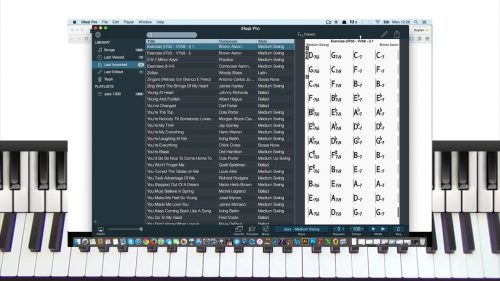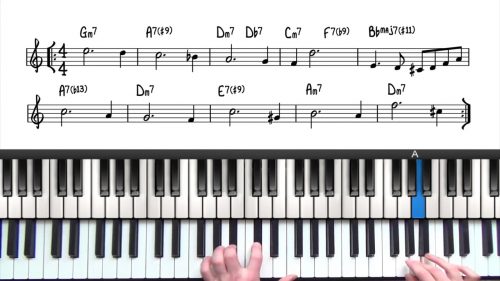Bossa Nova Piano For Beginners
Bossa Nova is a style of improvised music that originated in Brazil in the late 1950s.
In terms of harmonic structure, Bossa Nova has a lot common with jazz music as both share a sophisticated use of seventh and extended chords.
Whilst Bossa Nova is most commonly associated with the guitar, it’s also widely played on the piano both in a band and in a solo context.
3 Elements: Bass, Chords, & Melody
It’s important to understand that playing solo Bossa Nova on the piano is much more difficult than in the context of a band.
It is a challenge for the solo pianist to maintain the 3 core elements of Bossa Nova which is a steady bass line, syncopated chords and finally the melody on top. In a band these 3 roles are spilt out between the bass player, the piano and the vocalist or horn player.
I’m going to break down these core elements individually and then we will put them all together.
Lesson Downloads
-
Bossa Nova Lesson Supplement File Type: pdf
Practice Tips
-
Start by isolating the bass line in your left hand. Play along with a metronome and ensure that you are anticipating the downbeats.
-
Next isolate the example right hand comping rhythm. There are many different comping rhythms used in Bossa Nova and understand that you can mix and match these different rhythms during a performance.
-
When putting both hands together, focus on accuracy. Play as slowly as you need to and gradually increase the tempo.
-
The next step is practice chord transitions over a Bossa Nova groove. You should be familiar with the concept of rootless voicings. If this is new to you, check out the related lessons on this page.
- Playing rootless voicings will ensure smooth voicing leading between the chords and they will also give you easy access to the upper extensions and alterations in your right hand.








Great intro to bossa nova and great sound quality! I’m glad to see the new bossa nova section. By the way, the first time you’re demonstrating an Ebmaj9, I think you’re doubling the third so it ends up being a Ebmaj7.
Thanks Matt, I’m glad you liked this introduction series! With teaching Bossa Nova, I find it’s important to take a methodical approach and isolate each element of the Bossa Nova groove.
And yes you’re correct, my pinky slipped up to the 3rd with that demonstration. You have the choice of playing either a ‘vanilla’ 7th chord, or adding in extensions such as the 9th… variety is key here so follow your ears and play what you like the sound of :-)
Cheers,
Hayden
how do i get started with this is i am a complete beginner? do i have to start somewhere else?
Hi Tank,
Yes start with our beginner jazz piano lessons: pianogroove.com/jazz-piano-lessons/ – the first 3 courses are all very important.
You can also see our beginner syllabus here: pianogroove.com/community/t/beginner-jazz-courses-roadmap-syllabus/1264
Cheers!
Hayden
In another lesson Jovino mentions the anticipited bass notes played as ghost notes. Is that the way they should be played in Bossa Nova too ?
thanks
Hi Tom,
Yes that’s correct we can use ghost notes in Bossa Nova bass lines to enhance the rhythmic feel.
In this course I break down the harmonic elements of Bossa Nova voicings, in particular the types of rootless voicings that we can use over the basic bass line.
Bossa Nova is not a style that I specialise in, and so to get the authentic rhythmic feel of the grooves, definitely defer to Jovino’s lessons and teachings as he is a master of this style.
His lessons are certainly more advanced and he explains the construction of the voicings a little less, so after you have taken the harmonic principles from this course I would recommend that you copy and emulate Jovino’s phrasing, accents, ghost notes, and other rhythmic nuances of his playing.
We are shortly launching the ‘live’ aspect of the website and Jovino will be hosting a live monthly session on different Brazilian topics. Students can ask him questions for direct feedback and guidance which is exciting.
Stay tuned in the forum for more updates on this: pianogroove.com/community/
Cheers,
Hayden
Hi Hayden,
I’ve finally got some time to devote myself to the keyboard. So I thought I’d start with the Brazilian areas.
So, thanks for putting together such a great program.
Cheers
Jennifer
My pleasure Jennifer.
For the more authentic lessons on this subject definitely check out Jovino’s Brazilian Grooves course:
pianogroove.com/bossa-nova-lessons/brazilian-grooves-course/
These lessons are more advanced but are taught by a true master of the Brazilian piano style.
This course is more accessible as I try to break down the concepts as simply as possible, and so after studying these harmony lessons I’d recommend checking out Jovino’s lessons.
You might also like the following live seminars by Jovino:
Bossa Nova Audio Tour: pianogroove.com/live-seminars/bossa-nova-audio-tour/
Triste & Summer Samba: pianogroove.com/live-seminars/bossa-nova-breakdown/
Brazilian Rhythms For Beginners: pianogroove.com/live-seminars/brazilian-rhythms-for-beginners/
Hand Independence: pianogroove.com/live-seminars/developing-hand-independence/
If you click on the “more” button below the live seminar videos, you can “Bookmark” them so that they appear on your dashboard, here’s a walkthrough of how to bookmark lessons: pianogroove.com/jazz-piano-lessons/how-to-bookmark-lessons/ – I should create a similar guide to bookmarking seminars.
Cheers,
Hayden